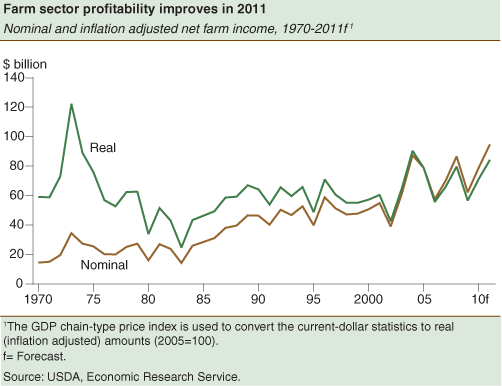Net Farm Income Expected To Increase 20 Percent in 2011
- by Mitch Morehart and Timothy Park
- 3/14/2011
Net value added, net farm income, and net cash income--the three key U.S. farm sector financial indicators--are expected to improve in 2011. Net farm income (a measure of profitability that accounts for inventories and capital consumption), is forecast to reach $94.7 billion in 2011, up nearly 20 percent from the 2010 forecast, and the second highest inflation-adjusted value for net farm income in the past 37 years. Over the past three decades, the top five years for nominal earnings have occurred since 2004, attesting to the profitability of farming in 2000-2009.
Net value added, USDA's measure of agriculture's contribution to the U.S. economy's production of goods and services, is forecast to rise by $18.4 billion (14.2 percent). Net cash income (a measure of the ability to pay bills and make payments on debt) mimics these increases and is projected to increase $7.3 billion (8 percent).
Double-Digit Increases in Crop Cash Receipts Expected in 2011
Crop receipts are expected to rise over 14 percent ($24.1 billion) in 2011, led by sales of corn, cotton, soybeans, and wheat. Rising cash receipts for cattle and calves are expected to increase livestock receipts by 3 percent ($4.3 billion) in 2011. Government payments paid directly to producers are expected to total $10.6 billion in 2011, 12.7-percent less than in 2010.
Total production expenses are projected to jump $20.2 billion (7.0 percent) in 2011, accelerating from a relatively modest 2-percent increase in 2010. Most major expense categories are forecast to rise in 2011, with the largest increases expected for fuel, fertilizer, and feed. Fuel costs are forecast to be 16 percent higher, reflecting the continued worldwide economic recovery that will strengthen demand for currently tight supplies of most types of fuel. Fertilizer prices are moving up due to higher production costs and increasing demand. Rising grain and soybean prices are expected to push feed costs 10 percent higher for U.S. livestock producers. This is the first time that nominal production expenses are projected to exceed $300 billion. Despite crossing this threshold, 2011 inflation-adjusted expenses are still expected to remain below the levels reached in 1979 and 1980.
The increase in cash receipts and expenses will affect crop and livestock farms differently. Even though the principal expenses for each type of farm are going up nearly the same (crop-related expenses should increase around $4.2 billion while livestock-related expenses should increase $4.4 billion), cash receipts are forecast to rise much more for crop producers than for livestock producers. As a result, farm businesses that specialize in the production of cash grains, soybeans, and cotton could see average farm incomes rise over 20 percent in 2011. Farm businesses specializing in livestock production, on the other hand, will likely see lower farm incomes this year, as livestock-related expenses (particularly in feed which represents more than a third of total operating costs) increase more than cash receipts.
With prospects for higher incomes for crop producers, the real (inflation-adjusted) value of farm assets and equity are projected to rebound past 2007 levels. Farm sector assets are expected to rise by 6.1 percent in 2011, while farm debt is forecast to increase by less than 1 percent. As a result, the real value of the farm sector's equity (assets minus debts) is forecast to exceed $2 trillion for the first time since 1979 and 1980.
This article is drawn from:
- Farm Sector Income & Finances. (n.d.). U.S. Department of Agriculture, Economic Research Service.


